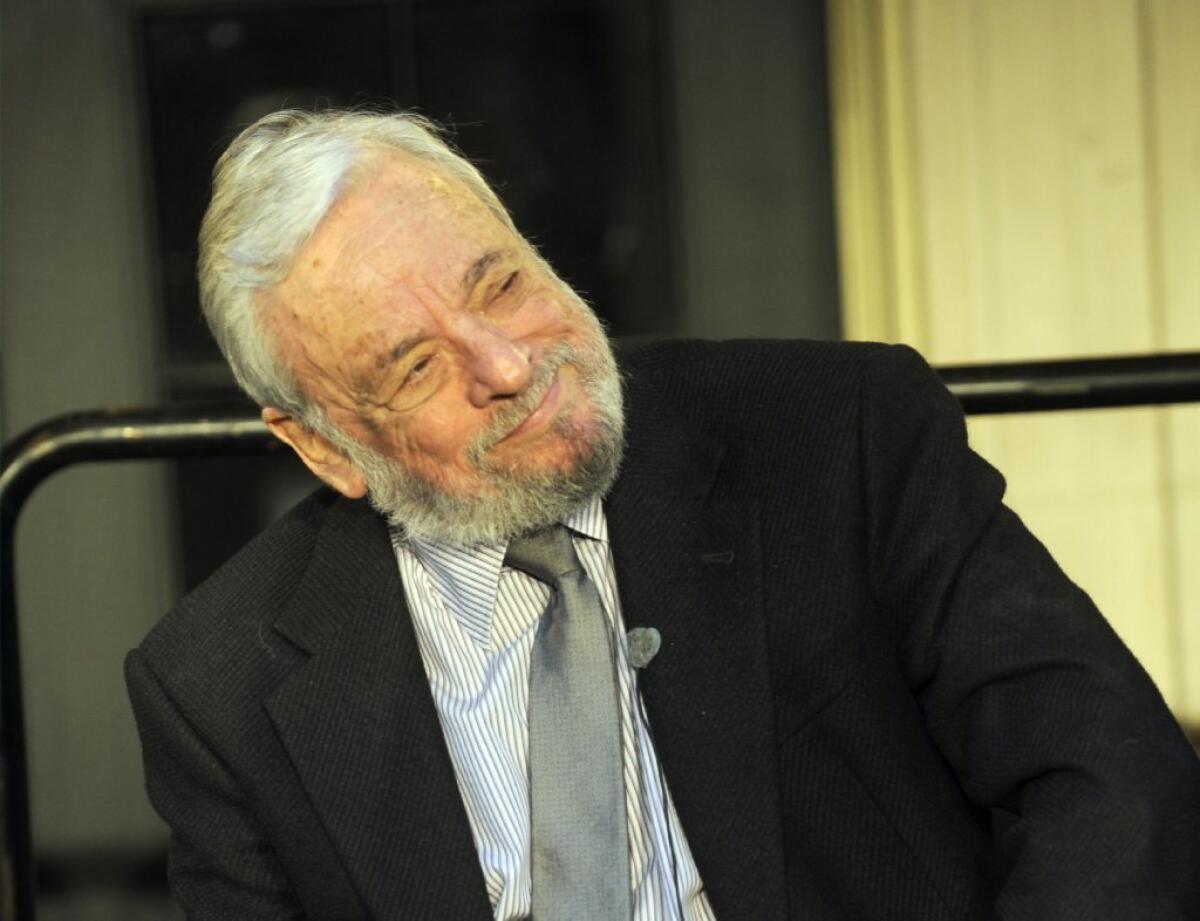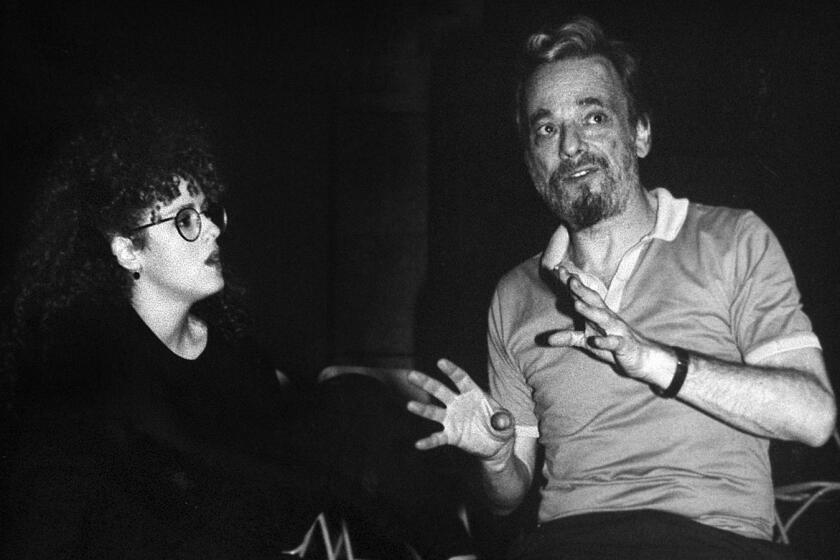How Stephen Sondheim changed theater forever — one musical masterpiece at a time

- Share via
Stephen Sondheim had a habit of firing off letters to the editor when the book writers of his shows were given short shrift in the media. The sentiment was more than collaborative graciousness. What separated Sondheim, who died Friday at age 91, was his recognition that writing musicals is fundamentally an act of playwriting.
“I think any good musical starts with the book, the libretto, the idea, the story, the characters,” he told director Richard Eyre in “Talking Theatre: Interviews With Theatre People.” “I can’t work on anything until I’ve discussed for weeks and sometimes months with my collaborator what the story is, why is music needed, why is music intrinsic as opposed to decorative, and what will music do to the story.”
No one can feign shock when a nonagenarian shuffles off his mortal coil, but the magnitude of Sondheim’s death feels seismic. I’ve been called upon to write postmortem appreciations of Arthur Miller, August Wilson and Edward Albee — and only their legacies come close.
Sondheim deserves a spot on playwriting’s Mt. Rushmore, for his contribution to the theater is as significant from a literary as it is from a musical standpoint. In truth, you can’t separate the words from the notes in his scores any more than you can pry apart form from content in his shows.
When Bob Dylan won the Nobel Prize in literature in 2016, I thought an equally smart outsider choice would have been Sondheim, who similarly approached songwriting as a dramatic art. It is no exaggeration to say that Sondheim changed the nature of theatrical storytelling. Through his lyrical cleverness and openness to dramatic invention, through his canny balancing of romanticism and anti-romanticism, he carved out space for ambivalence in a popular art form that leaned heavily on sentimental simplicity.
The theater legend behind seminal works from “West Side Story” to “Sweeney Todd” has a show on Broadway and a movie due soon.
In “Finishing the Hat,” the first of his magnificent two-volume edition of collected lyrics and commentaries, Sondheim stressed that “every lyric in this collection is prompted by the beginning, middle or end of a culmination of incidents before it.” “In Buddy’s Eyes” from “Follies” may seem like a beautiful middle-aged love number when performed in a cabaret. But, as he explained, the number “loses much of its tone and all of its subtext when disconnected from the placid surface of its music and the scenes and dialogue which have preceded it.”
“How can we know what Sally means or what she’s trying not to say, without knowing Sally?” he writes. “It’s as if we were asked to know Hamlet from his soliloquies alone, for what are solo songs but musicalized soliloquies, encapsulated moments even when addressed to other characters?”
Of course Sondheim didn’t invent “the book musical.” But he was a young disciple of Oscar Hammerstein II, who helped the American musical make an evolutionary leap into a more integrated form, first in his work with Jerome Kern on the 1927 musical “Show Boat” and later in his celebrated collaborations with Richard Rodgers.
The only child of affluent New York dressmakers, Sondheim essentially became part of Hammerstein’s country household after his parents divorced and he moved with his formidable socialite mother to Bucks County, Pa. Sondheim looked to Hammerstein as a “surrogate father,” who opened up the possibility of theatrical songwriting. At the time, Sondheim was a precocious young classical piano player being groomed for a concert career. Broadway wasn’t in the cards.
In recounting Hammerstein‘s profound influence, Sondheim recalled to Eyre: “I showed him everything I wrote from the age of fifteen on, and he treated it absolutely on a level with professional work. … As a result of Oscar I think I probably knew more about writing musicals at the age of nineteen than most people do at the age of ninety.”
What made Sondheim a disciple wasn’t simply the sterling example of musical theater craftsmanship. It was Hammerstein as the restless innovator that drew him. Although “Hammerstein is usually thought of as the Norman Rockwell of lyricists, earthy, optimistic, sometimes ponderously bucolic,” Sondheim held that “the more apt comparison would be with Eugene O’Neill,” in the sense that “they are both experimental playwrights with things to say profound enough to override their literary limitations.”
Hugh Jackman, Audra McDonald, Anna Kendrick, Sarah Silverman and Brian Stokes Mitchell paid their respects Friday to the esteemed musical theater icon on social media.
A crucial early experience for Sondheim was working as an assistant on “Allegro,” a musical experiment from Rodgers and Hammerstein, who were looking to break new ground after “Oklahoma!” and “Carousel.” The show didn’t coalesce, but it changed the way Sondheim thought about musical drama.
“Right away I accepted the idea of telling stories in space, of skipping time and using gimmicks like the Greek chorus,” he said. The riddle of the musical’s failure became an obsession for him. Producer Cameron Mackintosh, recognizing just how formative the show was in Sondheim’s development, told him, “You’ve spent your life trying to fix the second act of ‘Allegro.’”
Sondheim didn’t disagree. In fact, he acknowledged that the experience was as consequential as “West Side Story,” the 1957 show in which he made his Broadway debut as a lyricist, alongside composer Leonard Bernstein, book writer Arthur Laurents and director-choreographer Jerome Robbins.
The prospect of collaborating on the score with Bernstein excited Sondheim, but the young composer had misgivings about joining the team strictly as a lyricist. Hammerstein, once again serving as the benevolent hand of fate, advised him not to pass up the opportunity of working with such gifted professionals.
After this landmark success, Sondheim was determined to conquer Broadway as a composer. But another lyric-writing opportunity came about that he found impossible to pass up: a musical inspired by the memoir of burlesque entertainer Gypsy Rose Lee.
“Gypsy,” which reunited Sondheim with Laurents and Robbins, was a great leap forward in his approach to Broadway songwriting. He worked closely on the musical’s dramatic movement with Laurents, who took him to sessions at the Actors Studio to illuminate how an actor approaches a role. Sondheim also benefited from the musical versatility and collaborative readiness of composer Jule Styne.
Sondheim harbored resentment that the show’s star, Ethel Merman, didn’t want to take a gamble on him as a composer. But what the team achieved was nothing short of groundbreaking — a musical that revealed new possibilities of dramatic complexity through its character-centered vision.
A doc illuminates the dark hold of Sondheim’s ‘Assassins’ in a Classic Stage Company benefit reminding us why theater has been such a pandemic loss.
“My approach is closest to that of an actor,” Sondheim reflected in an interview in “The Art of the American Musical: Conversations With the Creators.” “I inhabit the character the way I think an actor does. Often by the time we’re through, I know the script better than the author does because, like an actor, I examine every line and every word.”
“West Side Story” and “Gypsy” would be crowning achievements for any theater artist, but Sondheim was just getting started. He wrote both the music and lyrics for “A Funny Thing Happened on the Way to the Forum,” which turned into a big hit, even if his score was overlooked in the raft of Tony nominations.
The introduction of Sondheim as a lyricist of unsurpassed cleverness, combined with what many consider to be a defiant lack of tunefulness in his scores, hampered the critical appreciation of his skills as a composer. Even after the flourishing of his dual gifts in the string of musical productions directed by Hal Prince that revolutionized the Broadway musical (“Company,” “Follies,” “A Little Night Music,” “Pacific Overtures” and “Sweeney Todd”), a few still considered Sondheim a modern-day Lorenzo Da Ponte in search of his Mozart.
But these conceptually daring shows with Prince, while not always commercially successful, replenished a Broadway landscape that had grown fallow. Sondheim didn’t invent the concept musical, but he revealed with unsurpassed style that it could think and feel at the same time. More significant, perhaps, he showed that it could deal with emotions that were ambiguous, repressed or even downright contradictory.
Sometimes the complexity became too demanding for audiences, as was the case in “Merrily We Roll Along,” the backward-moving musical about the artistic ambitions and compromises of a trio of friends over a 20-year span. The disappointment over “Merrily,” which closed shortly after it opened on Broadway, caused Sondheim and Prince to go their separate ways for two decades.
Of all the show tunes in the history of musical theater, Adam Driver sings “Being Alive” from “Company” — a choice that makes the Netflix movie even more layered, profound and heartbreaking.
But Sondheim continued to take risks, finding vitality with new collaborators. The most important among these was book writer and director James Lapine, whose more intimate off-Broadway imagination elicited from Sondheim a heady mix of mature emotion. Their two masterpieces, “Sunday in the Park With George” and “Into the Woods,” while as adventurous as any of the shows with Prince, are flooded with gorgeous melancholy.
Sondheim’s work with writer John Weidman — “Pacific Overtures,” “Assassins” and “Road Show” — brought out a biting political edge. The American story, in all its seething ironies, found its songwriter — for those who prefer their anthems laced with sardonic critique.
Broadway would bend to Sondheim, not the other way around, even if it would take more than a decade for a show like “Assassins” to make it there. While jukebox musicals dominated the commercial scene, sensational revivals of Sondheim shows (including John Doyle’s productions of “Company” and “Sweeney Todd,” Laurents’ revival of “Gypsy” with Patti LuPone and Sam Buntrock’s delicate reimagining of “Sunday in the Park With George”) continually reminded audiences what the American musical is capable of.
Unlike in Britain, where knighthoods are bestowed, in America artists as consequential as Sondheim don’t always receive their due. But Sondheim was justly celebrated. He received the Presidential Medal of Freedom from President Obama in 2015 and was the recipient of star-studded birthday concerts when he turned 80 and then again (via Zoom during the COVID-19 pandemic) when he turned 90 last year. There were documentaries (including Lapine’s brilliant “Six by Sondheim”), cabarets, recordings and movie musicals to introduce a new generation to Sondheim’s singular genius.
Singular but never solo. The appreciations lavished upon Sondheim by the theater community were in part a reflection of the extensive network of talent he was inspired to uplift. His career harked back to the Broadway golden age of Hammerstein and Bernstein, but Sondheim was always ready to embrace the next generation, whether in the hip-hop-inflected vision of a young Lin-Manuel Miranda or in the glorious drag parody of Randy Rainbow.
In the newly released film “Tick, Tick … Boom!”, Sondheim (played by Bradley Whitford) is shown lending much needed support to a struggling Jonathan Larson, who would go on to write “Rent.” Sondheim knew from personal experience the value of an encouraging word from one change-maker to another.
For the eternally young doyen of the Broadway musical, even revivals were an opportunity for trying something new. A new film version of “West Side Story,” directed by Steven Spielberg, opens in December to update this classic for a contemporary audience. And in Broadway previews right now, a novel production of “Company,” directed by Marianne Elliott and starring Katrina Lenk as a female Bobbie, has New York once again abuzz.
No words can do Sondheim justice, but his own (from “Sunday in the Park With George”) capture the liberated artistic spirit that kept Broadway marching, despite its timidity, into the future:
Stop worrying if your vision
Is new.
Let others make that decision —
They usually do.
You keep moving on.
More to Read
The biggest entertainment stories
Get our big stories about Hollywood, film, television, music, arts, culture and more right in your inbox as soon as they publish.
You may occasionally receive promotional content from the Los Angeles Times.













